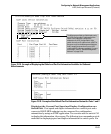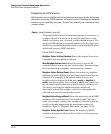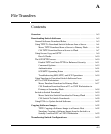
Configuring for Network Management Applications
LLDP (Link-Layer Discovery Protocol)
Figure 13-25. Matching Internal Port Numbers to External Slot/Port Numbers
ProCurve# walkmib ifDescr
ifDescr.1 = A1
ifDescr.2 = A2
ifDescr.3 = A3
.
.
.
ifDescr.23 = A23
ifDescr.24 = A24
ifDescr.27 = B1
ifDescr.28 = B2
ifDescr.29 = B3
.
.
.
ifDescr.48 = B22
ifDescr.49 = B23
ifDescr.50 = B24
.
.
.
Beginning and Ending of Port
Number Listing for Slot A
Beginning and Ending of Port
Number Listing for Slot B
LLDP and CDP Data Management
This section describes points to note regarding LLDP (Link-Layer Discovery
Protocol) and CDP (Cisco Discovery Protocol) data received by the switch
from other devices. LLDP operation includes both transmitting LLDP packets
to neighbor devices and reading LLDP packets received from neighbor
devices. CDP operation is limited to reading incoming CDP packets from
neighbor devices. (ProCurve switches do not generate CDP packets.)
LLDP and CDP Neighbor Data
With both LLDP and (read-only) CDP enabled on a switch port, the port can
read both LLDP and CDP advertisements, and stores the data from both types
of advertisements in its neighbor database. (The switch only stores CDP data
that has a corresponding field in the LLDP neighbor database.) The neighbor
database itself can be read by either LLDP or CDP methods or by using the
show lldp commands. Take note of the following rules and conditions:
13-76


















